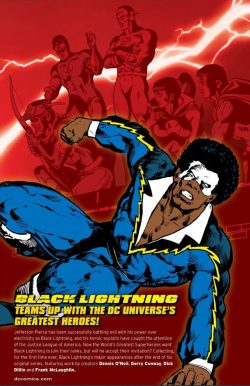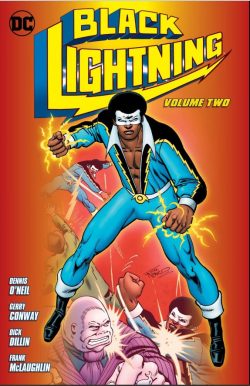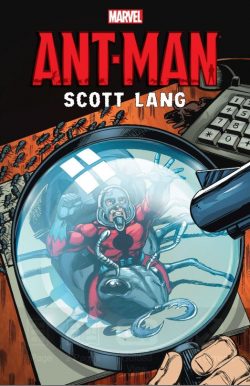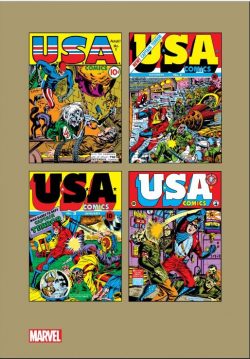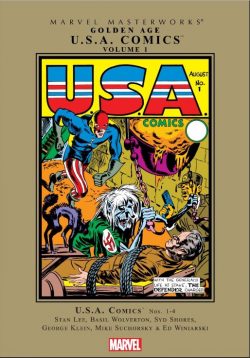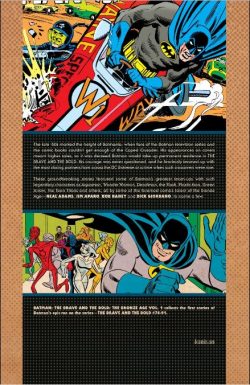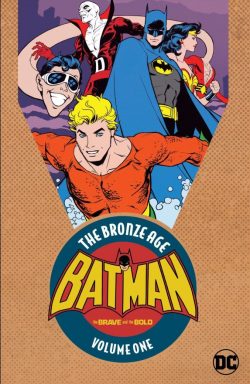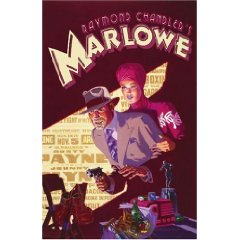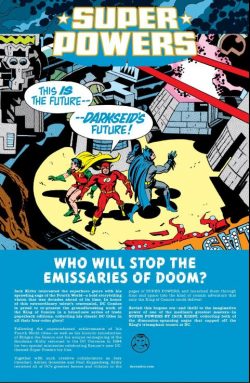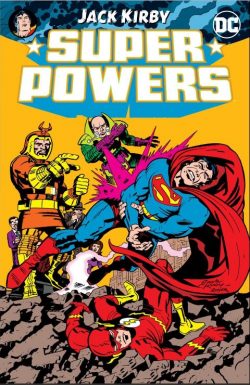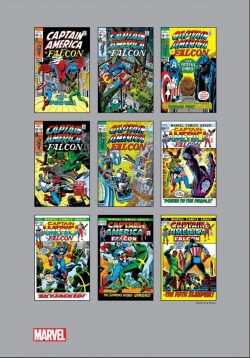
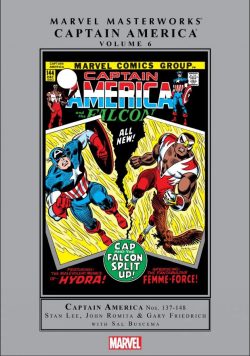
By Stan Lee, Gary Friedrich, Gene Colan, John Romita, Gray Morrow, Sal Buscema & various (Marvel)
ISBN: 978-0-7851-5875-2 (HB)
Created by Joe Simon & Jack Kirby in an era of frantic patriotic fervour, Captain America was a dynamic and highly visible response to the horrors of Nazism and the threat of Liberty’s loss.
He faded away during the post-war reconstruction but briefly reappeared after the Korean War: a harder, darker sentinel ferreting out monsters, subversives and the “commies†who lurked under every brave American kid’s bed. Then he vanished once more until the burgeoning Marvel Age resurrected him just in time for the turbulent, culturally divisive 1960s.
By the time of the tales gathered in this sixth Masterworks volume (available in luxurious hardback and accessible eBook formats) – comprising issues #137-148 of his monthly comicbook from May 1971 to April 1972 – the Star-Spangled Avenger had become an uncomfortable symbol of a troubled, divided society, split along age lines and with many of the hero’s fans apparently rooting for the wrong side.
Now into that turbulent mix crept issues of racial and gender inequality…
Following a fond and forthright reminiscence from illustrator John Romita in his Introduction, the action opens here with the Star-Spangled Avenger, still notionally working with – if not for – super-scientific government spy-agency S.H.I.E.L.D. (which back then stood for Supreme Headquarters International Espionage Law-enforcement Division), returning to Earth after a blistering battle against the malign Mole Man. With him was his now full-time, fully-fledged partner the Falcon.
As scripted by Stan Lee and illustrated by Gene Colan & Bill Everett, the neophyte hero, seeking to impress his mentor, opts ‘To Stalk the Spider-Man’. This typical all-action Marvel misunderstanding led to plenty of unnecessary fighting until forestalled as mob boss Stone-Face returns to settle old scores in #138’s ‘It Happens in Harlem!’
John Romita the elder returned to the art chores to depict Spider-Man and Cap rescuing the Falcon and ending the gangster’s dream of monetising New York’s racial unrest before the Good Captain is whisked away for a top-secret mission heralding the beginning of a lengthy and direction-changing saga…
For years Captain America had been the only expression of Steve Rogers‘ life, but with the next issue the man went undercover as a police officer to solve a series of disappearances and subsequently regained a personal life which would have long-term repercussions.
Once Spidey, Falcon and Cap trounced Stone-Face, the Red, White and Blue is subsumed by plain Rookie Blues in ‘The Badge and the Betrayal!’ and Steve finds himself on a Manhattan beat as the latest raw recruit to be bawled out by veteran cop Sergeant Muldoon…
Meanwhile, as police officers continue to disappear in increasing numbers and Rogers is getting into more fights on the beat than in costume, social worker Sam (Falcon) Wilson is challenged by seductive black activist Leila Taylor and undergoes a far from voluntary and unwanted audition for S.H.I.E.L.D. …
Issue #140 reveals the plot’s perpetrator as ‘In the Grip of Gargoyle!’ takes events in a frankly bizarre direction, with moody urban mystery inexplicably becoming super-spy fantasy as the villainous Grey Gargoyle steals a mega-explosive from S.H.I.E.L.D. and turns the Falcon into his petrified minion.
With Joe Sinnott inking, Lee & Romita deliver ‘The Unholy Alliance!’ as the stony duo attack a secret base stockpiling ultimate explosive Element X, with Cap, renewed love interest Sharon Carter and Nick Fury attempting to save the world and the Falcon from the Gargoyle…
Spectacular but painfully confusing until now, the epic was dumped on new writer Gary Friedrich to wrap up with ‘And in the End…’ (Captain America and the Falcon #142) wherein the resurgent heroes race a countdown clock of doom to save the day…
All this time Sam had been trying to get friendly with “Black Power†activist Leila and, with the sci fi shenanigans over, a long-running subplot concerning racial tensions in Harlem boiled over…
‘Power to the People’ and ‘Burn, Whitey, Burn!’ (both from giant-sized #143 with Romita inking his own pencils) sees the riots finally erupt with Cap and Falcon caught in the middle, before copping out with the final chapter by taking a painfully parochial and patronising stance and revealing that the seething unrest amongst the ghetto underclass has been instigated by a rabble-rousing fascist super-villain in ‘Red Skull in the Morning… Cap Take Warning!’
Nevertheless, Friedrich made some telling and relevant points – and continued to do so in CA&F #144’s first story ‘Hydra Over All!’ (illustrated by Romita) with the creation of S.H.I.E.L.D.’s all-woman attack squad Femme Force One (stop squirming – at least they were trying to be egalitarian and inclusive…). To facilitate their efficacy they were assigned to train with the Sentinel of Liberty himself…
The issue also offered a solo back-up tale ‘The Falcon Fights Alone!’ (by Friedrich and drawn by the great Gray Morrow) wherein the street vigilante designs a new uniform and rededicates himself to tackling the real problems on his turf: drug-dealers, thieves, racketeers and thugs endangering the weakest, poorest members of society…
Captain America and the Falcon #145 expanded the Hydra storyline with ‘Skyjacked’ (stunningly illustrated by Gil Kane & Romita) as the hooded terrorists kidnap Cap’s new team in mid-air…
Sal Buscema began his long tenure on the series with ‘Mission: Destroy the Femme Force!’ and ‘Holocaust in the Halls of Hydra!’ (#146 and inked by John Verpoorten) wherein devious dealings in the halls of power are uncovered before Falcon races to the rescue of the severely embattled and outgunned heroes, culminating in the unmasking of the hidden operator behind the villainous throne in #147’s ‘And Behind the Hordes of Hydra…’: a staggering battle royale in Las Vegas with a hierarchy of old villains exposed, wherein the ultimate power behind the power reveals himself in Friedrich’s swansong ‘The Big Sleep!’
Rounding out the riotous adventure, bonus extras include the cover to the all-reprint Captain America Annual #2, assorted house ads and a rare Romita colour rough for Captain America #139…
Any retrospective or historical re-reading is going to turn up a few cringe-worthy moments, but these tales of matchless courage and indomitable heroism are always fast-paced, action-packed and illustrated by some of the greatest artists and storytellers American comics has ever produced.
As the nation changed Captain America was finally discovering his proper place in a new era and would once more become unmissable, controversial comicbook reading, as we shall see when I get around to reviewing the next volume…
© 1971, 1972, 2012, 2017 Marvel Characters, Inc. All rights reserved.

